Treasure Island
San Francisco, CA
Treasure Island sits in the heart of San Francisco Bay with the new Bay Bridge serving as a dramatic backdrop – an extraordinary location that will soon be home to one of the most transit-oriented sustainable developments in the country. As a part of the master plan, Treasure Island and neighboring Yerba Buena Island are being transformed into an environmentally sustainable new 21st-century San Francisco neighborhood for more than 18,000 residents in the middle of San Francisco Bay. The reimagined neighborhood is part of a visionary redevelopment featuring 8,000 new homes including 2,700 homes that will be permanently affordable, 300 acres of parks, trails and open space, new restaurants and shops, public art installations, and exciting events.
In the midst of the design process, we decided to rotate the grid 35 degrees to orient streets and buildings southerly. We want to warm homes and parks with as much direct sunlight as possible while minimizing wind channels.
